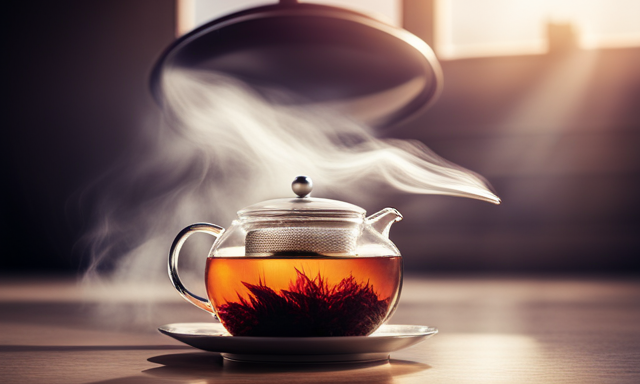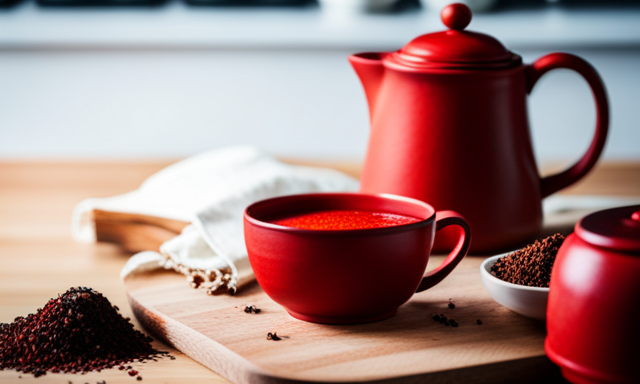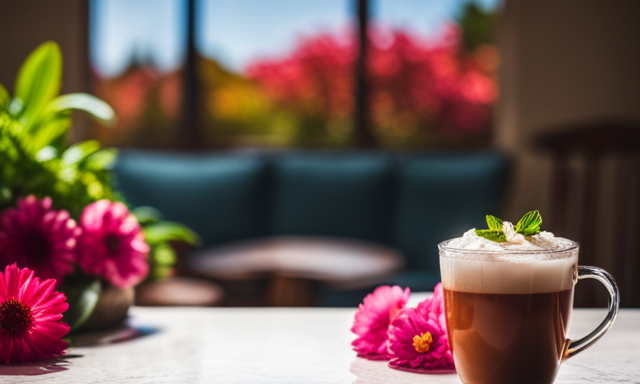When it comes to enjoying a warm cup of rooibos tea, the question often arises: how many times can you steep it?
Well, let me tell you, my fellow tea lovers, the answer might surprise you. As a passionate tea enthusiast, I have explored the depths of this aromatic beverage, and I am here to share my knowledge with you.
Steeping rooibos is an art in itself, a delicate balance between extracting the flavors and avoiding bitterness. In this article, we will dive into the intricacies of the steeping process, uncover the secrets of achieving the perfect cup, and even explore the possibilities beyond the first steep.
So, grab your favorite teapot and join me on this tea-filled adventure as we unravel the mysteries of rooibos and discover just how many times we can steep it to savor its unique taste to the fullest.
Key Takeaways
- Rooibos can be steeped multiple times for a nuanced experience
- Discard leaves after the third steeping for a robust cup
- Adjusting water temperature can enhance the taste of rooibos
- Experiment with steeping duration to find preferred strength and taste
Understanding the Steeping Process
Did you know that you can steep rooibos multiple times to extract its full flavor? Adjusting steeping techniques and experimenting with different water temperatures can greatly enhance the taste of your rooibos tea.
The first time you steep rooibos, it releases its initial flavors, but it doesn’t stop there. By re-steeping the leaves, you can uncover new layers of complexity and richness. The key is to adjust the steeping time and water temperature based on your preference.
If you like a stronger flavor, increase the steeping time or use hotter water. If you prefer a milder taste, decrease the steeping time or use cooler water. This way, you can enjoy multiple cups of delicious rooibos tea without compromising on quality.
Now, let’s delve into the next section to understand more about the quality of rooibos tea.
Quality of Rooibos Tea
When it comes to enjoying the best cup of rooibos tea, using high-quality tea leaves is essential. High-quality rooibos tea leaves have a vibrant color, a fresh aroma, and a rich flavor that is unmatched.
Additionally, it’s important to understand the differences between loose leaf and tea bags. Loose leaf rooibos tea allows for a better infusion and a more nuanced taste. On the other hand, tea bags may contain lower quality leaves and result in a less flavorful cup of tea.
Using high-quality rooibos tea leaves
If you’ve got top-notch rooibos tea leaves, you can steep ’em multiple times to extract every last bit of flavor. It’s all about the steeping techniques and knowing how to get the most out of your leaves. Here are some tips for using high-quality rooibos tea leaves:
-
Use a tea infuser or a teapot with a built-in strainer to allow the leaves to fully expand and release their flavor.
-
Experiment with different steeping times to find your preferred strength. Generally, 5-7 minutes is recommended for rooibos tea.
-
Don’t be afraid to play around with water temperature. Rooibos can be steeped in boiling water, but some people prefer slightly cooler water to avoid any bitterness.
-
Enjoy the health benefits of rooibos tea, which include its high antioxidant content and potential to alleviate allergies and digestive issues.
Now, let’s explore the differences between loose leaf rooibos and tea bags.
Differences between loose leaf and tea bags
Utilizing high-quality rooibos tea leaves allows for a more nuanced flavor profile, which can be further enhanced by understanding the distinctions between loose leaf and tea bags.
The main difference lies in the steeping process. Loose leaf rooibos provides a more customizable experience as you can control the amount of tea and steeping time, resulting in a stronger or weaker brew. The larger surface area of loose leaf tea allows for a better extraction of flavors and essential oils, resulting in a richer and more aromatic cup.
On the other hand, tea bags offer convenience and a quicker steeping process, but the flavors may be less pronounced. It’s important to note that the first steep of rooibos tea always yields the strongest flavor, setting the foundation for subsequent infusions.
First Steep
To get the most out of your rooibos tea, steep it for about five minutes and let the vibrant red liquid infuse your senses. Adjusting the temperature and steeping time can make a big difference in the flavor and strength of your first cup. Here are three key factors to consider:
-
Water temperature: Rooibos tea is best steeped in boiling water, around 212°F (100°C). This ensures that the leaves release their full flavor and aroma.
-
Steeping time: Five minutes is generally the ideal steeping time for rooibos tea. This allows enough time for the leaves to fully infuse the water and create a rich, smooth cup of tea.
-
Experimentation: If you prefer a stronger or weaker cup of tea, feel free to adjust the steeping time accordingly. You can try steeping for a shorter time for a milder flavor, or steeping for a bit longer for a stronger brew.
Now, let’s move on to the next section and explore the magic of the second steep.
Second Steep
When it comes to the second steep of rooibos tea, there are a few key points to consider. Firstly, you can adjust the steeping time and temperature to extract the most flavor from the leaves.
Secondly, it’s important to note that the flavor and aroma of the second steep may be slightly different from the first steep, as some of the more delicate notes may have been released in the initial infusion.
Lastly, experimenting with different steeping methods can yield interesting results and allow you to discover new flavors in your rooibos tea.
Adjusting steeping time and temperature
If you want a stronger flavor, you can steep rooibos for a longer period of time, allowing the flavors to fully develop. This will result in a bolder and more robust cup of tea. However, be mindful not to steep it for too long, as it can become bitter. It’s recommended to start with an additional minute of steeping time and then adjust based on personal preference.
When experimenting with different temperatures, you can also influence the flavor profile of your rooibos tea. Here are four key points to consider:
- Higher temperatures (around 212°F or 100°C) can extract more flavor, producing a richer and more intense brew.
- Lower temperatures (around 180°F or 82°C) can result in a milder and smoother cup, perfect for those who prefer a delicate taste.
- Steeping rooibos at room temperature for a longer period of time can create a unique, naturally sweet infusion.
- Cold brewing rooibos overnight in the refrigerator can yield a refreshing and subtly sweet iced tea.
By adjusting steeping time and experimenting with different temperatures, you can tailor your rooibos tea to your personal preferences and enjoy a variety of flavors and aromas. In the next section, we’ll explore the changes in flavor and aroma that occur with each subsequent steep.
Changes in flavor and aroma
Exploring the changes in flavor and aroma of rooibos tea offers a sensory journey that deepens the appreciation for this versatile beverage. The infusion techniques used and the steeping time greatly impact the flavor profile of rooibos. By adjusting the steeping time, one can alter the intensity and depth of the tea’s taste. A shorter steeping time of around 5 minutes results in a milder flavor, while a longer steep of 7-10 minutes intensifies the richness.
The aroma of rooibos also evolves with different steeping times, ranging from a delicate, floral scent to a robust, earthy aroma. These changes in flavor and aroma provide a delightful experience for tea enthusiasts.
Transitioning to the subsequent section about the ‘third steep and beyond’, the flavors continue to evolve, revealing new nuances and complexities with each subsequent infusion.
Third Steep and Beyond
Beyond the second steep, rooibos loses some of its robust flavor but can still be enjoyed as a soothing and mellow brew. To get the most out of each steep, it’s important to adjust the steeping duration and temperature.
For the third steep and beyond, I recommend steeping rooibos for a slightly longer duration, around 8-10 minutes, to extract as much flavor as possible. However, be careful not to steep it for too long, as it may become bitter. The optimal temperature for steeping rooibos remains around 200°F (93°C), as higher temperatures can result in a more astringent taste.
After the third steep, signs of exhausted leaves may start to appear, such as a weaker aroma and color. These indicators suggest it may be time to replenish the leaves and start a new brew.
Signs of Exhausted Leaves
When rooibos leaves have been steeped multiple times, they may exhibit signs of exhaustion. One key indication is a pale color, as the leaves have released most of their flavor and nutrients. Additionally, the flavor of the tea may become weak and lack the characteristic robustness of fresh leaves. It’s important to know when to discard the leaves to ensure a flavorful and enjoyable cup of rooibos tea.
Pale color and weak flavor
Despite its pale color and weak flavor, rooibos can still be steeped multiple times, allowing for a more nuanced and layered drinking experience.
The pale color and weak flavor of rooibos leaves after the first steeping may be disappointing to some, but this is actually a characteristic of the tea. Rooibos is naturally low in tannins, which are responsible for the strong flavors found in other teas. This means that the leaves don’t release all of their flavor and color in just one steeping. Instead, they gradually release their essence, resulting in a milder and more delicate taste.
The subsequent steepings of rooibos can still offer enjoyable sips, albeit with a lighter profile. However, it’s important to know when to discard the leaves to avoid an overly diluted cup.
When to discard the leaves
Although the flavor of rooibos gradually diminishes with each steeping, it’s important to discard the leaves after a certain point to prevent a watery and diluted cup of tea. Recognizing when to discard the leaves is crucial in maintaining the freshness and flavor of the brew.
As a tea enthusiast, I’ve found that after the third steeping, the leaves lose much of their potency, resulting in a weaker taste. To ensure a robust and flavorful cup, it’s best to discard the leaves at this point. However, if one prefers a milder brew, they may opt to steep the leaves for a few more times.
By understanding the discarding process and recognizing freshness, one can enjoy the perfect cup of rooibos tea.
Now, let’s move on to enhancing the flavor in the next section.
Enhancing the Flavor
To enhance the flavor of your rooibos, you can steep it multiple times, allowing the rich flavors to deepen with each infusion. Here are three ways you can experiment with steeping to maximize the taste:
-
Increase the steeping time: Try adding an extra minute to each subsequent infusion to extract more flavor from the leaves.
-
Adjust the water temperature: Play around with different temperatures to find the one that brings out the best taste in your rooibos.
-
Mix and match: Blend different types of rooibos or add complementary herbs and spices to create unique flavor profiles.
By exploring these techniques, you can truly unlock the full potential of your rooibos tea.
Now, let’s delve into the next section to discover the other uses for used leaves.
Other Uses for Used Leaves
Unlocking the full potential of your rooibos tea involves exploring other creative ways to utilize the used leaves. After steeping your rooibos tea, don’t throw away the leaves just yet. Instead, consider using them for composting or repurposing them as potpourri.
Rooibos leaves can be a valuable addition to your compost pile, providing nutrients and helping your plants thrive. Simply mix the used leaves into your compost bin and let nature do its magic.
Additionally, you can repurpose the leaves by drying them and using them as potpourri. The natural fragrance of rooibos leaves can add a pleasant aroma to any room.
By finding alternative uses for the used leaves, you can maximize the benefits of your rooibos tea experience.
Now, let’s move on to some tips for storage.
Tips for Storage
After exploring the various uses for used rooibos leaves, let’s move on to the next important aspect of rooibos tea: proper storage.
Proper storage is essential for prolonging the freshness and flavor of your rooibos. To keep your rooibos leaves in optimal condition, it’s best to store them in an airtight container, away from heat, light, and moisture. This will help prevent oxidation and maintain the quality of the leaves.
It’s also important to avoid storing rooibos near strong-smelling foods, as they can absorb odors easily. Additionally, try to use your rooibos leaves within a year of purchase for the best flavor.
By following these tips for storage, you can ensure that your rooibos tea remains fresh and delicious for as long as possible. Moving forward, let’s delve into the conclusion and final thoughts on rooibos tea.
Conclusion and Final Thoughts
In conclusion, storing your rooibos tea properly is crucial for preserving its freshness and flavor, ensuring that every sip is a delightful experience.
When it comes to steeping rooibos, you have the freedom to experiment with the duration to find your preferred strength and taste. Generally, rooibos can be steeped for 5-7 minutes to extract its full flavor potential. However, some people prefer a stronger brew and may steep it for a longer duration. It’s important to note that rooibos is naturally caffeine-free, so you don’t need to worry about it becoming bitter or oversteeping.
Remember to adjust the steeping time according to your personal preference, and enjoy the soothing and aromatic flavors of rooibos tea.
Frequently Asked Questions
Can I steep rooibos tea more than three times?
Absolutely! Rooibos tea can be steeped multiple times, allowing you to savor its delicious flavor over and over. With each steeping, the flavor may subtly change, becoming smoother and more delicate.
How long should I steep rooibos tea for each steeping?
For optimal flavor, steep rooibos tea for 5-7 minutes in boiling water. To reuse the leaves, increase steeping time by 1-2 minutes each time. Avoid steeping for too long to prevent bitterness.
Are there any specific signs to look for to determine if the rooibos leaves are exhausted?
As a tea connoisseur, I can tell when rooibos leaves are exhausted by their lack of color and flavor. To properly dispose of used leaves, compost them for a nutrient-rich soil amendment.
Can I enhance the flavor of rooibos tea without adding any additional ingredients?
To enhance the flavor of rooibos tea without adding any additional ingredients, I recommend steeping the leaves for a longer period of time. This allows the natural additives in the leaves to infuse the water, resulting in a stronger and more flavorful brew.
Apart from consuming rooibos tea, are there any other creative ways to use the used leaves?
Apart from consuming rooibos tea, the used leaves have a multitude of creative uses. They can be repurposed as a natural exfoliating scrub, infused in facial toners, or incorporated into homemade face masks for DIY skincare products. Get crafty and rejuvenate your skin!
Conclusion
In conclusion, you can steep rooibos tea multiple times, allowing you to fully savor its delicious flavors. Some may argue that the taste diminishes after the first steep, but I can assure you that with the right brewing techniques, the subsequent steeps can still be enjoyable. You can enhance the flavor and extract the maximum benefits from your rooibos tea by adjusting the steeping time and water temperature. So don’t hesitate to give it another go and experience the richness of rooibos tea over multiple steeps.










